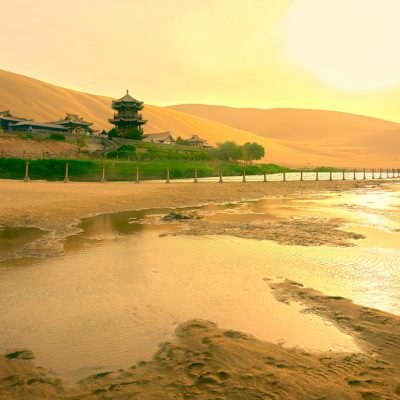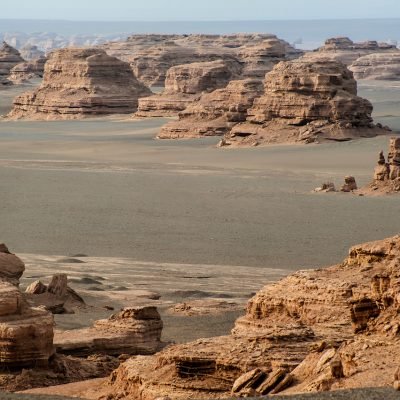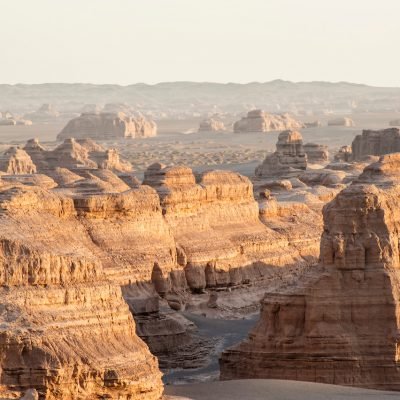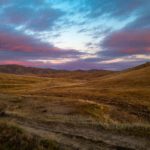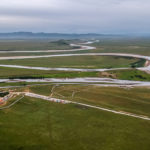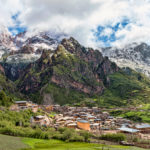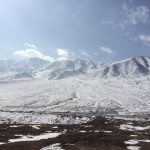According to legend, in 366 AD a monk named Yuezun had a vision of a thousand radiant Buddhas on the cliff face. This powerful vision inspired him to begin excavating the caves. From the 4th to the 14th century, hundreds of caves were then hand carved out of the rock cliff face containing scriptures, statues, and vibrant Buddhist paintings.Today almost 500 caves remain and there are more than a thousand painted and sculpted Buddhas within the caves which contain the world’s largest collection of Buddhist art.
Excavated into a mile of cliff face outside Dunhuang, an oasis town at the edge of the Gobi Desert, the site’s Chinese name Mogao Ku means “peerless caves.” Indeed, these caves are “peerless” and are one of the largest and best preserved artifacts in all of Asia. The decorated caves’ walls and ceilings, have a total area of 500,000 square feet and are covered by elaborate paintings depicting stories of the Buddha, Buddhist sutras, portraits of cave donors, ornamental designs, and scenes of social and commercial life. The caves also contain more than 2,000 brightly colored clay sculptures of the Buddha and other important Buddhist scholars, the largest sculpture being over 100 feet tall.
The settlement of Dunhuang was one of the first places where Buddhism entered China, through a steady stream of meditation, monks, and merchants who moved north and east from India along the Silk Road. As a major stop on the Silk Road, Dunhuang was a crossroads of Buddhist, Muslim, Hindu, and even Christian thought. Although this is an area of specifically Buddhist worship, the art and objects found at Mogao reflect the meeting of cultures along the Silk Road, the collection of trade routes that for centuries linked China, Central Asia, and Europe. Discovered at the site were Confucian, Daoist, and Christian texts, and documents in multiple languages including Chinese, Sanskrit, Tibetan, and Old Turkish. Even Hebrew manuscripts were found there.
After the 15th Century, the caves lay forgotten and were buried by the sand of the Gobi Desert for many centuries until they were rediscovered by a monk. In the 1890s a Daoist monk named Wang Yuanlu appointed himself guardian of the caves. In 1900 he discovered a cache of manuscripts, long hidden in a small sealed up cave, coming upon one of the great collections of documents in history. Despite their great age, the sculptures and wall paintings in the Dunhuang caves remain remarkably well preserved, thanks in part to the dry desert climate and their remote location.
As more and more archeologists investigated the cave over 50,000 ancient documents were found there. The Library Cave (Cave 17), which was unsealed by Wang Yuanlu, contained nearly 50,000 ancient manuscripts, silk banners and paintings, fine silk embroideries and other rare textiles dating from before the early 1000s, when this cave and all its contents were concealed for reasons still unknown. Shortly after this discovery, many of the objects from the cave were acquired at the site by explorers and archaeologists from the West and Japan.The materials found in the Library Cave offer a vivid picture of life in medieval China. Accounting ledgers, contracts, medical texts, dictionaries, and even descriptions of music, dance, and games were among the finds.
Many of the objects found in the Library Cave can actually be viewed online now. Museums and libraries across Europe and Asia with objects from the Library Cave in their collections have digitized them and made them searchable for free via the International Dunhuang Project, based at the British Library.
The Buddha himself meditated in caves before achieving Enlightenment, and sacred cave sites are found throughout the Buddhist world, including in Thailand, Myanmar, and Sri Lanka. India is home to some 1,200 cave-temple sites, China 250. The Mogao site at Dunhuang is the largest of these.
